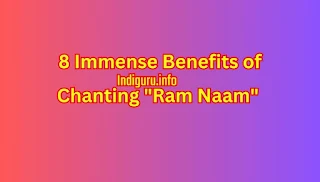In this article, I have written about 8 Immense Benefits of Chanting "Ram Naam" or the repetition of the name "Ram," a very significant and popular time-tested Mantra in Hinduism, which is the Name of Shri Ram; the 7th Avatar of Bhagwan Vishnu. The practice of chanting this Naam Mantra is believed to have several spiritual and psychological benefits, and it holds cultural and religious significance for many devote Hindus, especially Ram-Bhakts or Life-Long devotees of Rama.
I have described the eight main benefits associated with chanting Ram Naam:
1] Spiritual connection with the Divine: Chanting Ram Naam is considered a form of devotion and a means of connecting with the ever-existent divine. It can help individuals deepen their spiritual awareness and foster a sense of closeness to the divine.

2] Stress reduction and mental and physical relaxation: Like other forms of Mantra Meditation, chanting Ram Naam may help reduce stress and induce a state of calmness. The rhythmic repetition of the Mantra can have a soothing effect on the mind, promoting relaxation.
3] Focus and concentration: Chanting a Mantra requires concentration and focus. Regular practice of Chanting Ram Naam may enhance your ability to concentrate, helping to clear the mind of distractions and improve overall mental clarity.
4] Attraction of Positive Energy: Devotees believe that chanting Ram Naam can generate positive energy and purify the mind and body. The Ram Naam Mantra is often associated with qualities like love, compassion, and righteousness.
5] Cultural and Religious Significance: For many individuals, chanting Ram Naam is a cultural and religious practice rooted in Hindu traditions. It is seen as a way to honor and invoke the divine attributes associated with Lord Rama, an important figure in Hindu mythology who is also called “Maryada Purushottam” or the “Perfect Man”.
6] Self-discipline: The regular practice of chanting requires commitment and discipline. Engaging in a daily practice of repeating Ram Naam can contribute to developing self-discipline and a sense of routine.
7] Emotional well-being: Some practitioners believe that chanting Ram Naam can have a positive impact on emotional well-being by promoting feelings of love, joy, and peace. It is seen as a way to transcend negative emotions and foster a positive mindset.
8] Cultural continuity: Chanting Ram Naam is part of Hinduism's rich cultural and religious tapestry. For many, it represents a connection to their heritage and a way to participate in the spiritual practices of their ancestors.
It's important to note that the perceived benefits of chanting Ram Naam are subjective, and individuals may experience them differently according to their temperament. Additionally, the practice is deeply rooted in cultural and religious contexts, and its effects can vary from person to person. If you're interested in exploring this practice, approach it with an open mind and consult with knowledgeable practitioners or spiritual guides for guidance.
The Hindi video of the chanting of Ram Naam can be seen on our YouTube Channel: Ram Naam Jaap 21 Baar
I have described the eight main benefits associated with chanting Ram Naam:
1] Spiritual connection with the Divine: Chanting Ram Naam is considered a form of devotion and a means of connecting with the ever-existent divine. It can help individuals deepen their spiritual awareness and foster a sense of closeness to the divine.

2] Stress reduction and mental and physical relaxation: Like other forms of Mantra Meditation, chanting Ram Naam may help reduce stress and induce a state of calmness. The rhythmic repetition of the Mantra can have a soothing effect on the mind, promoting relaxation.
3] Focus and concentration: Chanting a Mantra requires concentration and focus. Regular practice of Chanting Ram Naam may enhance your ability to concentrate, helping to clear the mind of distractions and improve overall mental clarity.
4] Attraction of Positive Energy: Devotees believe that chanting Ram Naam can generate positive energy and purify the mind and body. The Ram Naam Mantra is often associated with qualities like love, compassion, and righteousness.
5] Cultural and Religious Significance: For many individuals, chanting Ram Naam is a cultural and religious practice rooted in Hindu traditions. It is seen as a way to honor and invoke the divine attributes associated with Lord Rama, an important figure in Hindu mythology who is also called “Maryada Purushottam” or the “Perfect Man”.
6] Self-discipline: The regular practice of chanting requires commitment and discipline. Engaging in a daily practice of repeating Ram Naam can contribute to developing self-discipline and a sense of routine.
7] Emotional well-being: Some practitioners believe that chanting Ram Naam can have a positive impact on emotional well-being by promoting feelings of love, joy, and peace. It is seen as a way to transcend negative emotions and foster a positive mindset.
8] Cultural continuity: Chanting Ram Naam is part of Hinduism's rich cultural and religious tapestry. For many, it represents a connection to their heritage and a way to participate in the spiritual practices of their ancestors.
It's important to note that the perceived benefits of chanting Ram Naam are subjective, and individuals may experience them differently according to their temperament. Additionally, the practice is deeply rooted in cultural and religious contexts, and its effects can vary from person to person. If you're interested in exploring this practice, approach it with an open mind and consult with knowledgeable practitioners or spiritual guides for guidance.
The Hindi video of the chanting of Ram Naam can be seen on our YouTube Channel: Ram Naam Jaap 21 Baar
Comments
Post a Comment